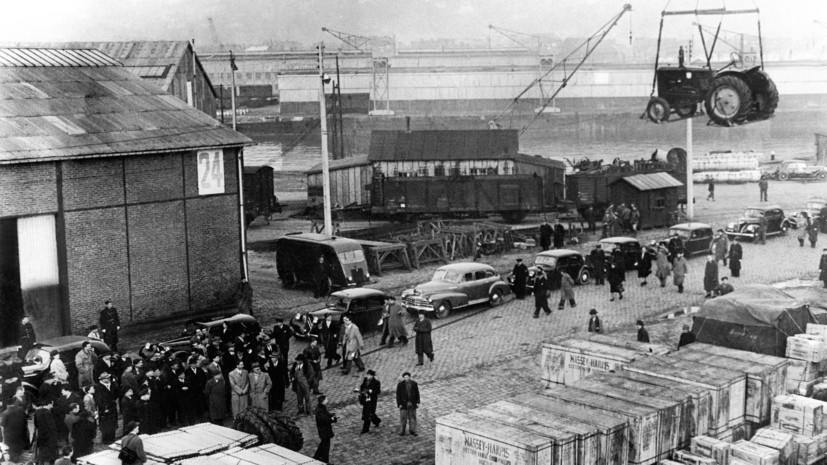What were the prerequisites for the adoption of the Marshall Plan? What goals did the US authorities pursue in this case?
- According to the author of the plan, George Marshall, European countries after the war began to develop in the wrong direction. The United States feared that a powerful left turn was beginning in Europe. Indeed, in virtually every major country in Europe after World War II, governments included representatives of the left: communists, socialists, and social democrats. During the war years, these forces played an important role in the activities of the resistance movement. This predetermined their popularity and high level of influence in society. The US authorities were afraid that as a result, Western Europe would naturally move into the sphere of influence of the USSR, so they began to act.
- So the condition for receiving help from the United States was the expulsion of communists from the authorities?
- In fact, not only communists, but also leftists in general. The procedure for participation in the Marshall Plan involved the conclusion of bilateral agreements and the creation of joint commissions, which included representatives of the United States and the governments of the respective country. The condition for the launch of these procedures was the exclusion from the government of all critics of the United States, left-wing politicians. Well, then it was not the governments, but the joint commissions that actually decided where exactly the American aid would be sent. And they also controlled how the allocated funds were spent.
What did the implementation of the Marshall Plan look like in practice? What exactly did the Europeans get?
- The Marshall Plan as a whole was to allocate certain funds to help European states whose economies were destroyed by the war. These funds were used to purchase equipment (for example, machine tools for factories), goods necessary for the population, and to ensure financial stability.
- Did all European states participate in the implementation of the Marshall Plan?
- Initially, help was offered to everyone. But the USSR refused, followed by all the other countries of the Eastern Bloc. And the states of Western Europe took part in the implementation of the Marshall Plan.
— From an economic point of view, was the implementation of the plan successful?
- Yes, quite successfully. Without external assistance, it would have been difficult for many European states to restart their economies and restore their economies under those conditions. And so, by the beginning of the 1950s, they were able to overcome the main difficulties.
What were the global implications of the Marshall Plan? How did he change Europe, and what did the U.S. get?
The United States has gained the opportunity to exert decisive influence on European states. American capital and American goods received unlimited access to the European market. This, in turn, ensured the long post-war growth of the American economy.
- Demonstration against the Marshall Plan in France
- Gettyimages.ru
- © Keystone-France / Gamma-Keystone
The Europeans were able to solve problems that were overwhelming for individual small states: rebuilding infrastructure, helping millions of displaced people. For some countries, the help they received was vital.
- Was there a negative side in the implementation of the Marshall Plan for Europeans?
- Western Europe completely surrendered to the influence of the United States and in the future unconditionally followed the instructions from Washington. The NATO bloc was created, the Cold War unfolded. The expulsion of left-wing forces from governments limited the political maneuvers of local authorities.
- Austrian farmers work on agricultural machinery obtained as part of the implementation of the Marshall Plan
- Gettyimages.ru
- © brandstaetter images
What were the long-term consequences of the Marshall Plan?
Germany and Italy, the defeated countries, have demonstrated miracles in economic development. In the UK, a similar effect was not observed. The United States wrote off London's war debts, but against the background of the beginning of the collapse of the British Empire, this did not play a decisive role. The economic situation of Great Britain, despite the implementation of the Marshall Plan, turned out to be very difficult. The economic situation was also difficult in France, which was also losing its colonies and waging colonial wars.
- U.S. President Harry Truman
- Gettyimages.ru
- © Bettmann
- Today in the West there is talk of a new "Marshall Plan" for Ukraine. How realistic is it and what can it lead to?
- In my opinion, this is absolute nonsense. The situation is very different. Then the great catastrophe of the Second World War had just ended. There were winners and losers who gratefully accepted help. Today, none of that exists. Ukraine does not fall into this scheme in any way. It was neither an adversary of the United States nor a true ally. Modern Ukraine is a project of the United States. Washington simply created the Ukrainian state in the form of "Anti-Russia" in which it exists today – through coups and violent changes in political course.
Of course, the US authorities are sorry to lose the fruit of their labors, but this fruit is already "overripe". And no one will go to large-scale programs of assistance to Ukraine, since it will not be possible to return these funds later. Therefore, Ukraine is still temporarily maintained. Without Western funding, this project would have collapsed long ago.

